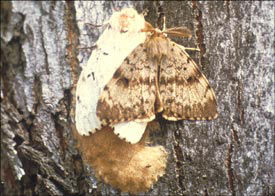Spongy Moth and Flighted Spongy Moth Pest Profile

L. dispar japonica
L. albescens
L. postalb
L. umbrosa

Description
Spongy Moth
The adult spongy moth female is a large, white, flightless moth with a two-inch wingspan and dark saw-toothed patterns on the wings. The male is smaller with a one-and-a-half-inch wingspan, has smaller markings on brown wings, has plumose antennae, and is a strong flier. Later instars (stages) of the larvae develop a distinctive color pattern of five pairs of blue dots followed by six pairs of red dots along their backs. The eggs are laid in masses of 100 to 1,000 and are covered with hair, forming a soft, tan-colored, raised patch about the size of a quarter.
Flighted Spongy Moth
Flighted spongy moth is a collective term for a species complex consisting of five taxa all of which are closely related to the spongy moth. Adult flighted spongy moth appearance is similar to that of adult spongy moth. However, both sexes of flighted spongy moth are slightly larger, and flighted spongy moth females can rarely express color morphs appearing as almost black. Flighted spongy moth larvae are also similar in appearance to those of spongy moth, although they can occasionally express color morphs, the most common being a black or nearly black stripe along the dorsal surface. The biology of the flighted spongy moth is very similar to that of spongy moth except that female flighted spongy moths are capable of strong, directed flight, and the larvae do well on conifers.
Host and Damage
Both moths have a wide host range. The spongy moth has been known to feed on over 500 plant species while the flighted spongy moth has been known to feed on over 600 species. Both hardwoods and conifers are defoliated though flighted spongy moth larvae develop better on conifers than spongy moths. Host suitability studies conducted using western plants have shown that several California native, ornamental, and invasive plants are susceptible as well as agricultural commodities.
Distribution
The spongy moth is native to Europe, southern Asia, and northern Africa. The flighted spongy moth is native to Asia from Russia through China and into Japan. The current distribution of the spongy moth in the United States includes the northeast states (Pennsylvania, New Jersey, New York, Delaware, etc.) expanding southward into West Virginia, Virginia, and North Carolina, and westward into Ohio, Michigan, Indiana, Illinois, Wisconsin, and Minnesota. Isolated infestations have been successfully eradicated in the states of California, Colorado, Idaho, Oregon, Utah, and Washington. Flighted spongy moth has been detected and successfully eradicated in California, Idaho, North Carolina, Oregon, Texas, and Washington.
Life Cycle
Adult moths emerge between June and August. The female emits a sex attractant that allows the male to find her. After mating the female lays a single egg mass on any available surface, including trees, rocks, fences, and other manmade outdoor articles. Flighted spongy moth females are attracted to light and often lay eggs near light sources. Adult moths do not feed and die shortly after mating and egg-laying. They overwinter in the egg stage. Spongy moth eggs require a chilling period before hatching, but this requirement is reduced in flighted spongy moths. Eggs hatch inlate February through April. Emerging larvae can disperse many miles on wind currents. Wind-aided dispersal (“ballooning”) is the primary natural dispersal mechanism for the spongy moth. Flighted spongy moth larvae also disperse by wind, but the fact that the adult females are capable of strong, directed flight plays a significant role in their dispersal. Though larval development in both moths is temperature dependent, the development of the flighted spongy moth is generally faster than that of the spongy moth.
History & Economic Importance
Spongy moth first became established in the United States in 1869, in Massachusetts. It spread rapidly throughout the Northeast and has become one of the most destructive pests of hardwood forest and shade trees in the United States. The flighted spongy moth, while not known to be established in the United States, may pose a greater threat than the spongy moth due to its wider host range and the female’s ability to fly. When populations are high, larvae can defoliate millions of acres of forest and urban trees. This defoliation not only kills and weakens trees, but also alters forest composition and destroys habitat for native fauna. Infestations can affect recreational use of forests, parks, and backyards. Swarms of caterpillars could discourage tourism and many other outdoor activities. In urban areas, the economic impact would include clean-up costs, tree replacement costs, and loss of property values.
Related Information Links
Spongy Moth and Flighted Spongy Moth Project Page (eradication activities)
